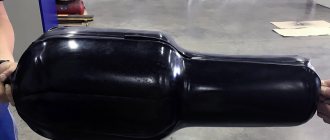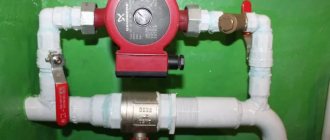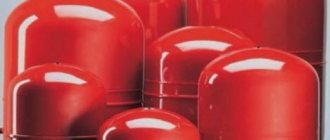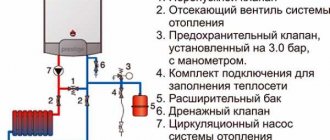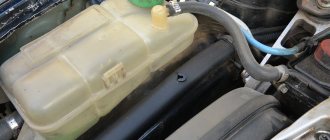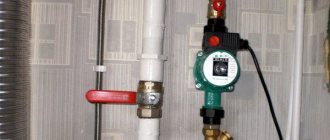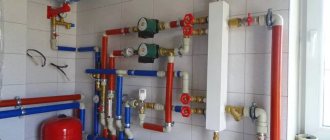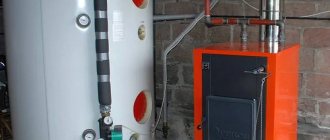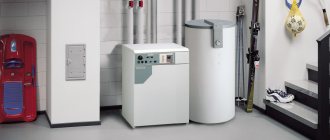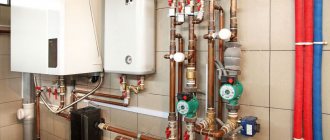An autonomous water supply system, which independently supplies water to distribution points as in a city apartment, has long ceased to be a curiosity. This is the norm of country life, which just needs to be properly designed, assembled and equipped with equipment capable of starting and stopping the system as the taps are used.
Stable operation of an independent network will be ensured by an expansion tank for water supply. It will protect against water hammer, significantly extend the service life of pumping equipment, guarantee regular filling of the system with water, and eliminate the need to carry it in buckets.
We are pleased to introduce you to the features of the device and the operating principle of the hydraulic accumulator. We carefully describe the rules for choosing a membrane tank, the specifics of installation and connection. We have supplemented the information offered for consideration with useful illustrations, diagrams and video tutorials.
Connection diagrams for hydraulic tanks
For a hot water supply system, the expansion tank is installed in the section of the circulation line, the suction line of the pump, closer to the water heater.
The tank is equipped with:
- pressure gauge, safety valve, air vent - safety group;
- shut-off valve with a device that prevents accidental shut-off.
In a water supply system where water heating equipment is present, the device takes on the functions of an expansion tank.
Installation diagram in the hot water system: 1 – hydraulic tank; 2 – safety valve; 3 – pumping equipment; 4 – filtration element; 5 – check valve; 6 – shut-off valve
In the cold water system, the main rule when installing a hydraulic accumulator is installation at the beginning of the piping, closer to the pump.
The connection diagram must include:
- check valve and shut-off valve;
- security group.
Connection schemes can be very different. The connected hydraulic tank normalizes the operation of the equipment, reducing the number of pump starts per unit of time and thereby extending its service life.
Installation diagram in a cold water system with a well: 1 – tank; 2 – check valve; 3 – shut-off valve; 4 – relay for pressure regulation; 5 – pumping equipment control device; 6 – security group
In a scheme with a booster pumping station, one of the pumps runs constantly. This system is installed for houses or buildings with high water consumption. The hydraulic tank here serves to neutralize pressure surges, and to accumulate water, a container of as large a volume as possible is installed.
What to look for when choosing?
Experts advise installing an expansion tank with a volume of 10% of the volume of the hot water boiler: a 100-liter boiler requires a 10-liter tank, a 200-liter boiler requires a 20-liter tank.
It is important to consider that a smaller capacity means the possibility of more frequent pressure surges. Do not forget that water is stored in the tank. This reserve may come in handy under certain circumstances.
You need to select a special hot water supply tank, for which such a possibility is provided structurally, indicated in the instructions. For example, heating system tanks require higher operating temperatures, but lower pressures. They provide the transfer of coolant at a “hotter” temperature, but the pressure there is relatively low. In such containers, little attention is paid to the hygienic characteristics of the materials. To help the consumer, tanks are made in different colors: blue, blue, white for water supply, red for heating. But it’s better to carefully read the product data sheet to avoid mistakes, since you can’t always trust the labeling.
The safety of using an expansion tank for water is determined by the material of the membrane and tank:
- rubber of natural origin - harmless in cold water, but you should not heat it above 50 degrees - negative reactions are possible;
- artificial rubber is suitable for water of various temperatures - up to boiling - without any consequences;
- rubber (ethylene-propylene) is similar in properties to artificial rubber - it has high performance properties;
- The tanks themselves are most often made of steel.
Another factor in choosing a tank is the manufacturer. A low price can often mean low quality of the product and, as a result, subsequent expensive repairs. A manufacturer with a name and reputation is not ready to sacrifice them, chasing fleeting benefits. They offer tanks and good quality components at reasonable prices. First of all, pay attention to the membrane material (see above), since the service life of the tank, the quality and safety of the water depend on this. The price of the membrane is not an empty question if we are talking about a tank with a replaceable rubber band.
Features of adjusting the hydraulic accumulator
Expansion tanks for water supply are sold with standard manufacturer settings - often the pressure in the air compartment is already set at 1.5 bar. The permissible pressure is always indicated on the label and the manufacturer does not recommend deviating from the specified parameters, especially in the direction of increasing it.
Before proceeding with the adjustment, the system is disconnected from the power supply and the shut-off valves are closed. The membrane tank is completely emptied by draining the water - an accurate pressure indicator can only be measured when the water compartment is empty.
Next, pressure readings are taken using an accurate pressure gauge. To do this, remove the decorative cap from the spool and bring the device. If the pressure differs from the required one, it is brought into compliance by pumping or bleeding excess air.
Considering that the manufacturer is against deviations from the recommended pressure values, it is necessary to select suitable equipment at the design stage, the parameters of which will not conflict with each other
When adjusting the pressure in the gas compartment of the tank, the manufacturer fills it with an inert gas, for example, dry nitrogen. This prevents corrosion of the inner surface. Therefore, users are also recommended to use technical nitrogen to increase pressure.
Setting the tank pressure in the water supply system
The pressure in a closed tank is always set slightly lower (by 10%) than the pressure level when starting the pump. By adjusting the pressure in the device, you can adjust the water pressure. The lower the gas pressure in the hydraulic tank (but not less than 1 bar), the more water it will hold.
In this case, the pressure will become uneven - strong when the tank is full and increasingly weak when it is empty. To ensure a strong and even flow of water, set the pressure in the chamber with air or gas to within 1.5 bar.
The water pressure in the water supply is set using a relay. When setting the pressure in the expansion chamber, these values must be taken into account
Adjusting the hydraulic tank in the water heater trim
The expansion tank, which is used for hot water supply, should initially not contain water. The pressure in the device is set at a value that is 0.2 greater than the upper pump shutdown threshold.
For example, if the relay is configured to turn off the equipment at a pressure of 4 bar, then the pressure in the gas compartment of the expansion tank should be set to 4.2 bar.
Installed in the water heater piping, the tank does not serve to maintain pressure. It is designed to compensate for expansion when water is heated. If you set the pressure in it to a lower value, then there will always be water in the tank.
Where to put the tank
Let's start with the fact that only closed heating systems are installed in private houses. The water flow circuit itself may have open spaces, or rather, one thing is the expansion tank, which can be open or closed, but besides this, the heating system is usually aimed only at heating the house.
In rare situations, a boiler is connected to it, but that's a completely different story.
Traditionally, the connection diagram for an expansion tank is closed or open near the heating boiler.
If we talk about a private house, then this should happen in the boiler room, and in the case of an apartment, heating boilers are usually located in the kitchen, and therefore the expansion tank should be installed there.
In addition, you need to immediately think about the fact that access to this tank was free and convenient for its use or maintenance - there is no need to put it in strange places or behind cabinets.
But we are not finished with the fastening yet. At the same time, we must have a valve to connect the expansion tank.
Although, to be more precise, this valve will control the access of liquid from the system to the expansion tank.
So, this valve is usually not very light, but it should not have a physical impact on the expansion tank - it should have its own supports or fastenings so that these two parts are independent.
Hydraulic tank maintenance rules
A routine inspection of the expansion tank consists of checking the pressure in the gas compartment. It is also necessary to inspect the valves, shut-off valves, air vent, check the operation of the pressure gauge and water pressure switch. To ensure the integrity of the tank, an external inspection is carried out.
During preventive maintenance, the pressure in the hydraulic tank should be measured and adjusted if necessary.
Despite the simplicity of the device, expansion tanks for water supply still do not last forever and can break. Typical causes are rupture of the membrane or loss of air through the nipple. Signs of breakdowns can be determined by the frequent operation of the pump and the appearance of noise in the water supply system. Understanding how your accumulator works is the first step to proper maintenance and troubleshooting.
Replacing the membrane
You will most likely have to replace the membrane after a tank failure. In this case, you will have to perform certain types of work:
- disconnect the tank;
- use the nipple to release the pressure;
- We dismantle the flange in the place where the pipeline is connected;
- remove the membrane itself;
- We check for contamination in the inner surface of the tank. If there is dirt or rust, then we do a thorough washing and cleaning;
- It is also worth remembering that the membrane itself is extremely sensitive to oils. For this reason, they cannot be used as anti-corrosion agents, specifically on the inside of the tank.
Installation of an open type hydraulic tank
An open-type device is used less and less often, as it requires constant user intervention in its operation. An open expansion tank is an unsealed container that serves to generate pressure in the water supply system, accumulate water, and also serves as an expansion chamber.
The tank is connected to: a drain tap, pipes for the recirculation and supply pipes, a control and overflow pipe
The tank is installed above the highest plumbing point, for example, in the attic, water enters the system by gravity. Every meter the device rises increases the pressure in the water supply by 0.1 atmospheres.
To automate the process of providing water, the tank is equipped with a float switch and an automatic relay is installed that will turn the pump on and off.
The container is mounted in a frost-free room, covered with a lid to prevent dust and debris, and the walls are wrapped in mineral wool or other insulation.
This method of organizing water supply requires regular monitoring by the user, otherwise the water may freeze at subzero temperatures (if the room is not heated). The liquid will evaporate, so you will have to constantly add it.
In addition, such a container is bulky and not aesthetically pleasing; it requires an attic space in the house. But the main drawback of the device is that the tank is not designed to work under conditions of high water pressure in the system.
Types of heating systems
There are two main types of heating systems - open (unclosed) and closed (closed). The first ones are the simplest; the coolant in them flows through the pipes by gravity, without the help of pumps, obeying the laws of physics. The expansion tank for open-type heating is located at the very top of the circuit - higher than the top line of the batteries installed in the building. The pressure in such a heating circuit is quite low, close to atmospheric.
Expanding under the influence of thermal energy, the coolant needs to be partially removed from the heating circuit. This is precisely what the simplest expansion tank for open-type heating is used for, mounted above all the radiators installed in the house (often placed in the attic). The excess coming from the pipes is directed into it. If too many of them are formed, some of them are removed from the heating by gravity through a pipe welded to the expansion tank.
Despite their size and apparent simplicity of operation, expansion barrels play an important role in the reliability of the entire heating system.
The coolant in open (unclosed) heating systems is in direct contact with atmospheric air, since the expansion tanks here are not sealed. And if air bubbles form in pipes and radiators, they are removed through the tank itself, without the use of special valves. In addition to the expansion tank for an open heating system, circulation pumps are often installed here - in most cases they are installed immediately after the boiler, along with a bypass.
Closed (closed) heating systems are sealed - in them the coolant does not come into contact with atmospheric air. Features of installation of such systems:
- The mandatory use of circulation pumps is to ensure proper circulation of the coolant;
- Mandatory use of a safety group - it is responsible for releasing pressure;
- The use of automatic air vents is mandatory - there is no need to explain what they are responsible for.
The coolant here flows under pressure created by the circulation pump
And if in open systems special attention is paid to the slope of the pipes, then this slope is not needed here. The main advantage of closed heating is the rapid and much more uniform distribution of heat throughout the heated rooms
You can install an expansion tank for closed-type heating at any arbitrary point in the house - near the heating boiler, at the height of the second floor and in any other place. But most often, expansion tanks of closed-type heating systems are placed near heating boilers, along with safety groups.
Technical recommendations
Diagram of installation of a membrane tank
installation of a membrane tank
Before you begin connecting the accumulator to the water supply system, you should:
- Carefully study the instructions supplied with the equipment.
- Carry out technical pressure calculations and compare them with those specified in the standard operating manual.
- To carry out a quality installation, you need a wrench for detachable connections and plastic pipes and a wrench of the right size.
- To mount large-volume equipment, special brackets will be needed.
Mounting on brackets
Please note! Measurements and calculations of the equipment in use must be carried out by a highly qualified specialist. The quality of the water supply system depends on the accuracy of the calculations and measurements performed.
Many years of experience in using membrane tanks for water supply have shown that horizontal models are the best option. If you have a submersible pump connected, purchase and install vertical accumulators.
Why do you need an expansion tank?
Installation of such a device allows you to simultaneously solve two load-bearing technical problems, such as:
- contributes to fewer cycles used (switching off and on) of the pump, which allows you to increase its service life;
- allows you to protect the device from possible water hammer, which may indicate that the device is congested or the presence of differences in the electrical network. These points can make the device unstable;
- helps create a reserve volume of liquid, which will be under a certain pressure inside the system, providing an optimal level of water supply anywhere in the house. On average, the tank volume is about 30 liters, which makes it possible to provide one point with liquid for several minutes.
How to install correctly
Based on the installation methods, the device can be either vertical or horizontal. As for technical differences, most models do not have them. This must be taken into account when choosing a method for installing one of the membrane tanks for water supply. The installation process itself should not cause any special difficulties, so all the necessary work can be done independently, without involving third parties. But at the same time, you must have at least minimal experience in installing water supply networks.
Basic rules to follow:
- in order to avoid an increase in hydraulic resistance, no additional devices should be installed between the pump device and the tank;
- the case itself needs high-quality grounding, which will help avoid electrocorrosion in the future;
- the cross-section of the pipe used must be equal to or greater than the pipeline being connected;
- It is recommended that the connection be made using American quick-release fittings, which are used to connect to pipelines. They will make it possible to disconnect the device from all networks in case of emergency;
- installation should be carried out in a place where it would be convenient to carry out repairs and other types of maintenance work. It is necessary to take into account the size of the room in which the installation will be carried out.
Installing a device such as a membrane-type expansion tank will significantly increase the efficiency of the entire water supply device. An important role here will be played by the chosen type of installation of the main equipment and compliance with all technologies and requirements. If, for any reason, you doubt your abilities, you should entrust all the necessary work to specialists who will be able to make correct calculations and pay attention to all the nuances regarding the technological features and installation location of the expansion tank. There is no place for savings here, since certified and truly high-quality products will be expensive, but will also serve well, avoiding expensive repair work.
